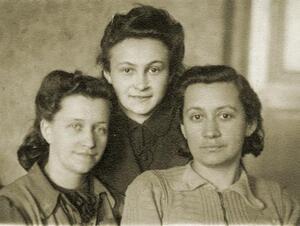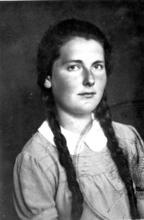Liza Czapnik
Liza Czapnik was traveling alone in 1941 when she witnessed the mass murder of Jews in Slonim. While she was interned in the Grodno ghetto with her family, no one believed the Nazis were as bad as Czapnik claimed. She became determined to leave the ghetto and join the partisans. After her parents were transported to Treblinka, she escaped to Bialystok and joined the underground, posing as an Aryan and working as a courier to smuggle messages, supplies, and weapons. In 1944 she became chair of the anti-fascist underground in Bialystok. After the war, she earned a PhD from the Moscow Pedagogical Institute of Foreign Languages in 1952 and taught English in Ryazan, Russia, until 1991, when she made Aliyah and settled in Beersheva.
Early Life
The youngest of four children, Elizaveta Iosifovna Czapnik was born in 1922 in Grodno, Poland (today Hrodna, Belorussia) to a traditional Jewish middle-class family which practiced Jewish observances until the Soviet occupation in September 1939. Czapnik studied at the Polish school and in the Jewish Gymnasium. Her father, Joseph (b. 1886), had a button shop and her mother, Ethel-Esther (b. 1888), was a seamstress.
During the Soviet occupation (1939–1941) Liza attended School No. 9 and was active in the Komsomol. She completed her studies on June 21, 1941. On the following day Germany invaded the Soviet Union. Czapnik and her family fled as the Germans advanced toward Grodno but her parents returned to the city. She herself, her sister Sarah (1912–1942) and her brother Grigorii (nickname Grisha, 1910–1943) went on, reaching Stolpce (Stowbtsy). German tanks surrounded them, the soldiers arrested the men but released the women. Her brother was among those detained in camps for Russian prisoners in Stolpce, where they were not fed for five days. Here Czapnik stood out for her determination and assertiveness, distributing to the prisoners bread and water that she had obtained from the Poles. Although the German guards beat her, she did not leave until her brother was released. Together with him and her sister, she walked to Baranowicze (Baranavichy), whence she proceeded alone to relatives in Dereczyn (Derechin). In August 1941, on the way from Dereczyn to Slonim, she witnessed a mass murder of Jews. She hid in the hollow of a tree and was found by a Belorussian woman who told her that the murdered people were the Jews of Slonim and suggested she disguise herself as her niece. After several days in Slonim, she returned to Dereczyn and thence to Grodno with a Polish wagon-driver who received her family’s furniture in exchange for taking her along. By now it was the end of 1941.
Beginnings of Resistance Work
In the ghetto, Czapnik lived with thirteen other people in a small two-room apartment. She and her brother were forced to live in hiding because they were wanted by the Gestapo. Their names appeared on the list of Jewish intellectuals, some of whom had been killed while Czapnik was in Dereczyn. Disappointed with the unbelieving response to her story of the murder in Slonim, she invested a great deal of time and effort in underground activity, which included listening to the news on a hidden radio in the attic of one of the homes, writing about what had happened in Slonim in newsletters and distributing them to Jewish acquaintances, meeting with members of the underground in their homes and preparing forged papers. In the controversy regarding modes of operation, Czapnik opposed armed struggle and advocated leaving the ghetto to join the partisans.
In October 1942 her father was arrested when she and her brother, who fled to Bialystok, were not found at home. In November 1942 her parents and relatives were transported to Kielbasin (a transit camp for onward transport to extermination camps) and then to Treblinka. A month later Czapnik left Grodno for Bialystok, equipped with forged papers in the name of Maria Mrozowska and the names and addresses of people at her destination. With the help of her brother Grisha she made contact with the members of the Bialystok ghetto underground.
In January 1943 Czapnik, who was a Komsomol member, was sent to the Aryan side of Bialystok to obtain an identity card based on her forged papers. In March 1943 her sister Berta (1908–1943) and husband were transferred to Bialystok and in August 1943 Berta, Grisha and Sarah were transported from Bialystok to Treblinka. Sarah jumped from the train and was shot and killed.
Czapnik’s documents enabled her to receive German identity papers and she found a place to live on the Aryan side where she worked as a potato peeler in the kitchen of the railway station. As a result she also received a certificate from the Labor Department. Together with Hasia Bielicka she succeeded in finding another job as a vegetable peeler and cleaning woman in the kitchen of the SS. Czapnik regularly managed to sneak into the ghetto through a courtyard common to the ghetto and the Aryan side, in order to receive missions from the ghetto underground. Her first such mission was to find hideouts with a cellar or garret for herself and other members of the underground. Another mission was to establish contacts with the Polish, Russian and Bielorussian anti-fascists. She made contact with members of the underground who worked in essential locations such as the airport and the power station. Together with other young Jewish women, she managed to make connections with various anti-fascist groups and unify them into one organization. The young women provided intelligence data about the Germans and, later, weapons they obtained in various ways.
Later Resistance Work
In February 1943 Liza Czapnik went to the Grodno ghetto once more, entering with a group of workers. She took her ten-year-old niece Alloczka from there, brought her to her hideout in Bialystok and returned her to her parents, who had arrived in the Bialystok ghetto with the remnant of the Jews of Grodno in March 1943. After rescuing her niece she changed apartments, moving to a secret room on another street. The room had a cellar where weapons, leaflets, papers and maps were hidden, together with anyone who came from the forest. She maintained contact with the Jewish underground in the ghetto, providing information and obtaining weapons and maps. She also resumed the connection with the non-Jewish underground, concealing weapons together with the other young women: Hasia Bielicka, Ania Rud, Marylka Rozycka, Bronia Klibanski (Winicki), Haika Grosman and Rivka Madajska.
When the Bialystok ghetto was liquidated in the aktion of August 1943, the connection between the young Jewish women was strengthened and they operated together. They began to help Jewish survivors reach the Aryan side and proceed from there to the forest. Until April 1944 Czapnik was one of the liaisons between the Jews who remained in hiding in Bialystok and the partisans, supplying clothing, weapons, medicines, maps and compasses for the Jewish Forojs (Yiddish “go out”) partisan unit led by Alexander Suhaczewski and commissar Rivka Vojskowska.
When the partisan force formed in their region, Czapnik was chosen to supervise the activities in the forest and report to the brigade command. Upon special orders from Moscow to unite all the anti-fascist forces, she was given the task of trying to contact the Armia Krajowa, AK (the Polish underground military organization), which for political reasons fought against the Soviet partisans. With the help of Bronia Klibanski, several members of the AK were brought to the headquarters of the partisan brigade, joined in the fighting and were afterwards relieved of their weapons. In April 1944 Czapnik was appointed chairperson of the anti-fascist underground organization of Bialystok. Other members were Bronia Klibanski of Dror, Haika Grosman, Hasia Bielicka of Ha-Shomer ha-Za’ir, Marylka Rozycka of the Communists and Ania Rud.
Postwar Life
Upon liberation, Czapnik returned to Grodno with Hasia Bielicka and Ania Rud. In 1945 she went to study in Moscow and in 1949 completed university studies at the Moscow Pedagogical Institute of Foreign Languages. After completing her postgraduate courses in 1952 she received her Ph.D. from the Institute. She was married to Ilya (Joel) Mashevitzky in 1951 and moved to Ryazan, where she taught English and translation. Their son Grisha was born in 1954. She remained in Ryazan until emigrating to Israel in 1991, residing in Beersheba.
Czapnik was the sole survivor of a large extended family.
Czapnik passed away on November 7, 2016, at the age of 93.
Bender, Sarah. “Young Jewish Women in Bialystok in a Fighting Alliance with Anti-Nazi Germans” (Hebrew). Yalkut Moreshet 61 (April 1996): 75–81.
Czapnik, Liza. Yad Vashem Archives 03/7309.
Fatal-Kenaani, Tikva. Not the Same Grodno (Hebrew). Jerusalem: 2001.
Grossman, H. The Underground Army. New York: 1987.
Ofer, Dalia and Lenore Weitzman, eds. Women in the Holocaust. New Haven: 1988, 109–119.
Shepelevich, Marina. Put' devushki iz Grodno: eshche odno voskhozhdenie. Grodno: UrSaPrint, 2015.




